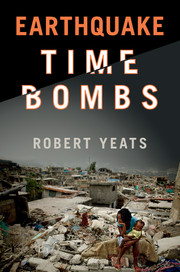Book contents
- Frontmatter
- Contents
- Acknowledgments
- Why this book?
- PART I EARTHQUAKES, DEEP TIME, AND THE POPULATION EXPLOSION
- PART II EARTHQUAKE TIME BOMBS
- TIME BOMBS WHERE THE PROBLEM IS UNDERSTOOD, BUT THE RESPONSE IS STILL INADEQUATE
- 6 San Francisco Bay Area
- 7 Los Angeles
- 8 Seattle, Portland, and Vancouver: Cascadia subduction zone
- 9 Japan: Tokyo and the Kansai
- 10 Wellington, New Zealand
- 11 Santiago, Chile
- 12 Prologue in central China
- OTHER TIME BOMBS, INCLUDING CITIES THAT ARE NOT WELL PREPARED
- PART III SUMMARY AND RECOMMENDATIONS
- References
- Index
11 - Santiago, Chile
from TIME BOMBS WHERE THE PROBLEM IS UNDERSTOOD, BUT THE RESPONSE IS STILL INADEQUATE
Published online by Cambridge University Press: 05 November 2015
- Frontmatter
- Contents
- Acknowledgments
- Why this book?
- PART I EARTHQUAKES, DEEP TIME, AND THE POPULATION EXPLOSION
- PART II EARTHQUAKE TIME BOMBS
- TIME BOMBS WHERE THE PROBLEM IS UNDERSTOOD, BUT THE RESPONSE IS STILL INADEQUATE
- 6 San Francisco Bay Area
- 7 Los Angeles
- 8 Seattle, Portland, and Vancouver: Cascadia subduction zone
- 9 Japan: Tokyo and the Kansai
- 10 Wellington, New Zealand
- 11 Santiago, Chile
- 12 Prologue in central China
- OTHER TIME BOMBS, INCLUDING CITIES THAT ARE NOT WELL PREPARED
- PART III SUMMARY AND RECOMMENDATIONS
- References
- Index
Summary
On February 27, 2010, the subduction zone off southern Chile was the source of the Maule earthquake of magnitude 8.8 in which 525 people were killed, including 23 in metropolitan Santiago (Metropolitana), with an additional 25 missing. Damage estimated by the reinsurance industry was $4–7 billion, and the cost to the national economy was $15–20 billion. These are large numbers until one considers that this was the sixth largest earthquake ever recorded by a seismograph. The losses were large, but considering that Maule was a superquake, the outcome could have been much worse.
Chile's response to the Maule earthquake was influenced by the fact that Chile has been struck by earthquakes on the Peru–Chile subduction zone many times during its recorded history of nearly 500 years. An earthquake of magnitude 9.5 on May 22, 1960 in southern Chile was the largest earthquake ever recorded on seismographs. At the time of the Maule earthquake, the government and the general population were aware of earthquakes, and, in the wake of the great 1960 earthquake, they had upgraded their building codes and zoning regulations. The losses of life accounted for only 0.4% of the population in the area affected by strong ground motion, a disaster but not a catastrophe.
The earthquake struck at the end of the summer holidays, and many of the casualties were tourists from other countries, who were completely unaware that Chile has an earthquake problem. Because Chile is a developed country, the Pacific Northwest can learn important lessons from the Maule earthquake, as pointed out in the resilience surveys summarized by CREW (2013).
Santiago, the capital of Chile, has a population of nearly six million, nearly one-third of the population of the entire country. The epicenter of the 1960 earthquake was 350 miles (570 km) south of Santiago, and the epicenter of the 2010 Maule earthquake was closer to Santiago: 210 miles (335 km) south of the capital city (Figure 11.1). There were damage and losses in the Santiago Metropolitana region from the Maule earthquake, but these were manageable. Santiago's test will come with a subduction zone megaquake directly opposite Santiago itself.
Like the cities of the Pacific Northwest, Santiago faces earthquakes from the South American crust in addition to earthquakes on the subduction zone.
- Type
- Chapter
- Information
- Earthquake Time Bombs , pp. 141 - 144Publisher: Cambridge University PressPrint publication year: 2015



